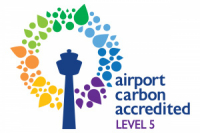Taking action for the climate
By reducing greenhouse gas (GHG) emissions in absolute terms and adapting to climate change to ensure that our business is viable over the long-term.
Climate change mitigation
The aim of mitigation is to reduce our carbon footprint and limit our impact on the climate.
This involves managing our energy consumption, developing renewable energies and gradually decarbonising our business activities.
We are also working with our partners, airlines and service providers to encourage them to use cleaner and more sustainable solutions.
We are prioritising sustainable transport, energy efficiency in buildings and optimising flows among other measures.
Our commitments:
- Achieve Net Zero Emissions for our own emissions (Scope 1&2) in absolute terms by 2030, then maintain this level.
- Achieve Net Zero Emissions across our value chain (Scope 3) in absolute terms by 2050, then maintain this level.
In order to meet these commitments, the three Côte d'Azur airports are participating in the voluntary Airport Carbon Accreditation programme.
To date, Cannes-Mandelieu Airport and Golfe de Saint-Tropez Airport are accredited at Level 4+ of the programme, while Nice Côte d'Azur Airport is accredited at Level 5, the most demanding level.
These accreditations are the result of concrete actions:
- Transitioning to 100% renewable electricity for all its facilities.
- Deploying a fleet of electric vehicles at the airports.
- Using of HVO 100 biodiesel for generators (ANCA).
- Optimising energy use in our facilities and equipment.
- Replacing gas boilers with geothermal and waste heat recovery systems (temperate water loop) or heat pumps
To meet our second commitment, the three Côte d'Azur airports are also working on decarbonising their value chain by focusing on the four pillars of aviation decarbonisation:
- Deploying sustainable aviation fuels: Replacing kerosene with aviation biofuels, reducing our carbon impact by 90% over their entire life cycle, in accordance with European regulations.
- Anticipating technological disruptions: Deploying infrastructure adapted to the energy transition of aircraft (hydrogen and electric).
- Fleet renewal: Taking advantage of technological advances in aircraft design (commissioning more energy-efficient and efficient aircraft).
- Optimising operations: Collaborating with authorities on optimising flight paths, continuous descent and improving taxiing times.
These key decarbonisation aviation areas are complemented by non-sector measures such as developing public transport and installing electric charging stations to decarbonise access to the airports and introducing responsible purchasing policies that include decarbonisation issues.
Tackling climate change is not limited to reducing emissions. We must also adapt to the changes already underway.
Adapting to climate change
Airports are particularly at risk when it comes to heat waves, heavy rainfall, flooding, rising sea levels and, in certain cases, forest fires.
We are strengthening our facilities to ensure that our airports remain safe, resilient and can continue to operate should such risks arise.
Key to this strategy is managing water use, greening spaces, monitoring weather patterns, maintaining facilities and designing sustainable facilities.
To reduce the vulnerability of our hubs and ensure their resilience, the three Côte d'Azur airports have each developed their own climate change adaptation plans for 2050, in line with French scenarios (TRACC), which are predicting an increase in average temperatures of 2°C by 2030, 2.7°C in 2050 and 4°C in 2100 compared to the pre-industrial era.
The climate is the concern of each and every one of us. Together we will build a more energy-efficient, resilient and environmentally friendly airport.
